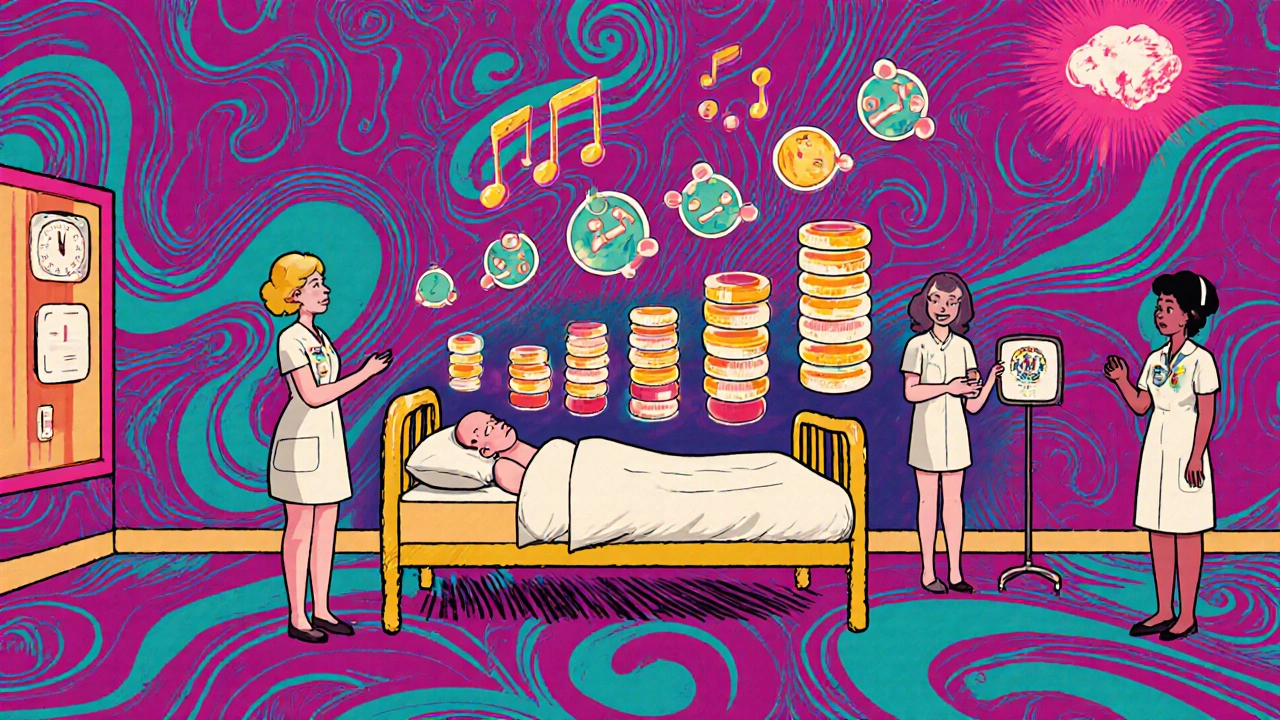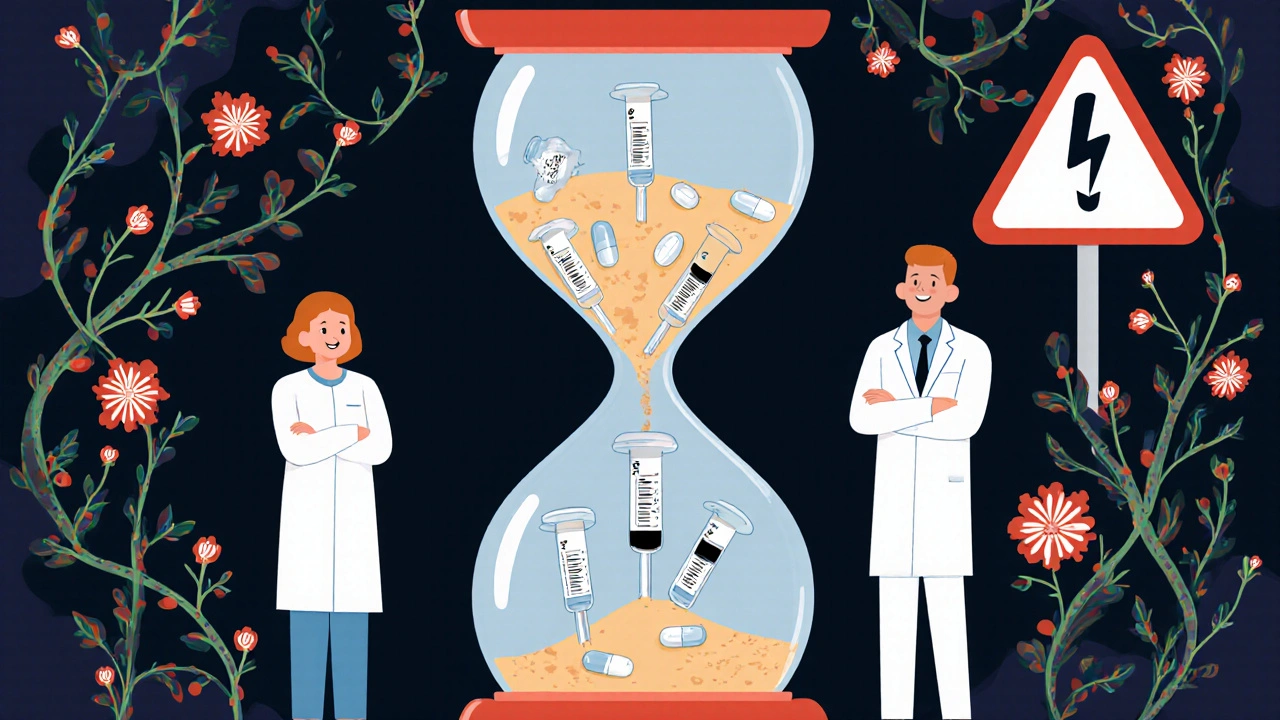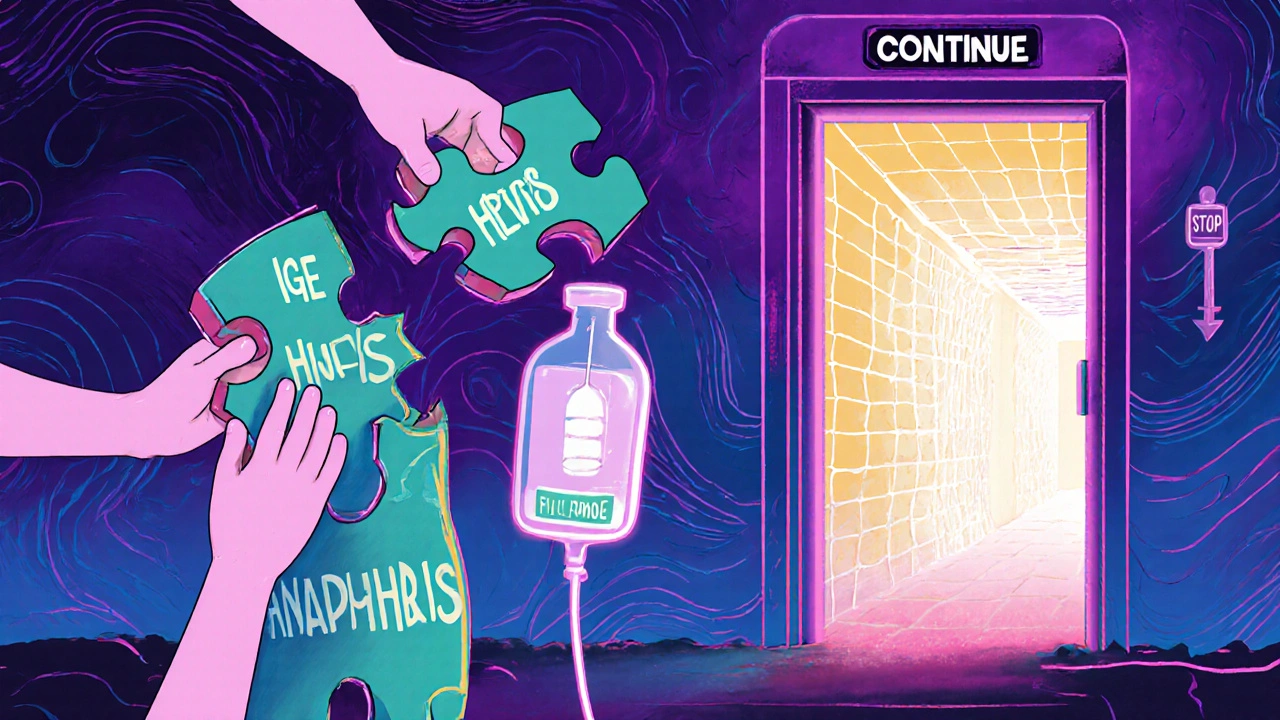
When you’ve had a serious allergic reaction to a drug-like hives, swelling, trouble breathing, or anaphylaxis-it’s natural to assume you’ll never be able to take it again. But that’s not always true. For many people, especially those needing life-saving treatments like chemotherapy, antibiotics for chronic infections, or biologics for autoimmune diseases, there’s a safe, proven way to get back on the medication: drug desensitization. It’s not a cure. It’s not a workaround. It’s a medically controlled process that lets your body temporarily tolerate a drug you’re allergic to, so you can complete your treatment.
What Drug Desensitization Actually Does
Drug desensitization doesn’t change your immune system. It doesn’t erase the allergy. Instead, it temporarily resets how your body reacts to the drug by slowly introducing tiny, increasing amounts over hours. Think of it like slowly turning up the volume on a speaker that’s too loud-you’re giving your body time to adjust before it hits the full blast. This method works best for IgE-mediated reactions (the kind that cause hives, swelling, or anaphylaxis) and some non-IgE reactions like aspirin sensitivity. It’s been used successfully for antibiotics like penicillin, chemotherapy drugs like carboplatin, monoclonal antibodies like rituximab, and even aspirin and NSAIDs. In fact, at major centers like Brigham and Women’s Hospital, over 90% of carefully selected patients complete the process without life-threatening reactions. The key word here is carefully selected. Not everyone qualifies. If you’ve had Stevens-Johnson syndrome, toxic epidermal necrolysis, or severe skin blistering from a drug, desensitization is off the table. The same goes for people who’ve had drug-induced hepatitis, kidney inflammation, or serum sickness. These are dangerous, systemic reactions that can’t be safely managed with dose escalation.How the Process Works Step by Step
Desensitization is never done at home. It’s always performed in a hospital or specialized allergy clinic with emergency equipment and trained staff on standby. Here’s how it typically unfolds:- Preparation: Your doctor reviews your reaction history and confirms the specific drug causing the problem. A written protocol is created just for you, including exact doses, timing, and backup plans.
- Start low: For IV drugs, the first dose is often 1/10,000th of your full therapeutic dose. For oral drugs like aspirin, it might be 1/100th. These amounts are so small they usually don’t trigger symptoms.
- Gradual increases: Every 20 to 30 minutes (for IV) or every hour (for oral), the dose is doubled. Most protocols use 12 to 16 steps. For example, a standard IV antibiotic protocol might go from 0.001 mL to the full 10 mL dose in about five to six hours.
- Constant monitoring: Your blood pressure, heart rate, oxygen levels, and breathing are checked after every dose. If you have asthma, spirometry tests are done to measure lung function. Nurses watch for any sign of itching, flushing, coughing, or dizziness.
- Adjust if needed: If you react-even mildly-the team might pause, give you antihistamines or steroids, then go back to the last safe dose before trying again. Sometimes they slow down the increases or use smaller steps.
- Reach full dose: Once you’ve received the full therapeutic dose without serious reaction, you’re considered desensitized. You’ll continue receiving the drug at full strength, usually every few hours or daily, depending on your treatment plan.
Why Timing and Continuity Matter
Desensitization only lasts as long as you keep taking the drug. If you stop-even for a day or two-your body can forget the tolerance. The moment you restart, you could react again. That’s why it’s critical to stick to the schedule. If you miss a dose, your doctor will likely restart the entire desensitization process from the beginning. This is especially important in cancer treatment. Patients receiving chemotherapy often need daily or weekly infusions. Missing one dose means going back to square one. That’s why many hospitals schedule desensitization before the start of a treatment cycle and keep patients under observation until the full dose is given safely. For drugs like aspirin or NSAIDs taken daily for pain or heart protection, patients may need to take them every day without interruption. Skipping doses can bring back the risk of severe asthma or anaphylaxis.
What Happens If You React During the Process?
Reactions during desensitization are rare-but they do happen. That’s why the procedure is done in a controlled setting with emergency drugs ready. If you develop mild symptoms like itching or a rash, the team will stop the infusion, give you antihistamines, and wait. Once symptoms settle, they may restart at the previous dose or even go back a step or two. If you have more serious symptoms-low blood pressure, wheezing, swelling in the throat-the team will immediately stop the drug, give epinephrine, oxygen, and steroids, and treat you like a medical emergency. In rare cases, the procedure is abandoned. But with trained staff and the right equipment, most reactions are handled quickly and safely.Who Benefits the Most?
Desensitization isn’t for everyone. But for certain patients, it’s the only way to survive. Here are the most common scenarios:- Cancer patients: If you’re allergic to carboplatin, paclitaxel, or other chemo drugs, desensitization lets you continue treatment instead of switching to less effective or more toxic alternatives.
- Autoimmune disease patients: If you need biologics like infliximab (for Crohn’s) or rituximab (for rheumatoid arthritis) but had a reaction, desensitization allows you to keep using them.
- Cystic fibrosis patients: Many are allergic to antibiotics like vancomycin or piperacillin-tazobactam. Without desensitization, they risk recurring lung infections.
- People with aspirin sensitivity: If you get severe asthma or anaphylaxis from NSAIDs, a multi-day aspirin desensitization protocol can help you tolerate daily low-dose aspirin for heart protection.
- Patients with local anesthetic allergies: Even if you react to lidocaine or similar drugs, a modified desensitization protocol can allow safe dental or surgical procedures.

Limitations and Real-World Access
Despite its success, desensitization isn’t widely available. You need a specialized allergy or immunology center with experience. Most community hospitals don’t have the staff, protocols, or emergency resources to do it safely. In Australia, the U.S., and parts of Europe, only major academic hospitals like Brigham and Women’s, the Asthma Center, or similar institutions offer it regularly. The American Academy of Allergy, Asthma & Immunology updated its guidelines in 2022 to standardize protocols for newer drugs like immune checkpoint inhibitors and tyrosine kinase inhibitors-showing how fast this field is evolving. But access remains limited. If your doctor suggests desensitization, you’ll likely be referred to a specialist center, which may require travel. Also, insurance doesn’t always cover it. Some plans see it as experimental, even though it’s backed by decades of research and published guidelines. Be prepared to advocate for yourself and ask for documentation from your allergist to support coverage.What Comes After Desensitization?
Once you’ve completed the process, you’re not “cured.” You’re just temporarily tolerant. You’ll need to keep taking the drug as prescribed. If you ever need to stop it for any reason-side effects, surgery, or a break in treatment-you’ll have to go through desensitization again before restarting. Some patients do develop long-term tolerance after repeated exposure, but this isn’t guaranteed. That’s why ongoing monitoring is key. Your allergist may recommend periodic skin or blood tests to check if your sensitivity has returned.Bottom Line: It’s Risky, But Often Worth It
Drug desensitization sounds scary. It involves giving you a substance you’ve had a life-threatening reaction to. But when done right-by experienced teams, in the right setting, with strict protocols-it’s one of the safest ways to get back on a drug you absolutely need. If you’ve been told you can never take a medication again because of an allergy, ask your doctor: Is desensitization an option? Don’t assume it’s not possible. For many, it’s the difference between life and death-or between continuing treatment and having to settle for something less effective.It’s not magic. It’s medicine. And for thousands of people each year, it’s the only path forward.
Can you desensitize to any drug allergy?
No. Desensitization is not safe for all types of drug reactions. It’s generally avoided in cases of severe skin reactions like Stevens-Johnson syndrome, toxic epidermal necrolysis, or drug-induced hepatitis and nephritis. It’s most effective for IgE-mediated reactions (like anaphylaxis, hives, swelling) and some non-IgE reactions like aspirin sensitivity. Always consult an allergy specialist to determine if your specific reaction type qualifies.
How long does a drug desensitization take?
It depends on the drug and route. Intravenous desensitization for antibiotics or chemotherapy usually takes 5 to 6 hours with 20-30 minute intervals between doses. Oral desensitization, like for aspirin, can take several days because doses are given much slower-often every hour or longer. The full therapeutic dose is typically reached by the end of the protocol, but the process may be extended if reactions occur.
Can you do drug desensitization at home?
Never. Drug desensitization must be done in a medical facility under direct supervision by trained staff with immediate access to emergency medications like epinephrine, antihistamines, and IV steroids. Even mild reactions can become life-threatening quickly. Home attempts are extremely dangerous and have led to fatal outcomes.
What happens if you miss a dose after being desensitized?
If you stop taking the drug-even for a day or two-your body can lose its temporary tolerance. When you restart, you may have the same allergic reaction again. In most cases, you’ll need to go through the full desensitization process again. That’s why consistency is critical, especially for daily medications like aspirin or ongoing treatments like chemotherapy.
Is drug desensitization covered by insurance?
Coverage varies. Some insurance plans recognize it as medically necessary, especially for cancer or autoimmune treatments with no alternatives. Others may deny it as experimental. Your allergist can provide clinical documentation and guidelines from the American Academy of Allergy, Asthma & Immunology (AAAAI) to support your claim. Always check with your insurer in advance and be prepared to appeal if needed.
Are there alternatives to drug desensitization?
Sometimes, but not often. If you’re allergic to a first-line cancer drug, antibiotic, or biologic, there may be no equally effective substitute. For example, replacing carboplatin with cisplatin can mean more kidney damage or hearing loss. Replacing penicillin for a cystic fibrosis patient may mean less effective infection control. Desensitization is often the only way to stay on the best possible treatment without compromising outcomes.
How do I find a doctor who does drug desensitization?
Start with a board-certified allergist or immunologist. Major academic medical centers and specialized allergy clinics are most likely to offer this service. In Australia, look for hospitals with allergy departments linked to universities or large teaching hospitals. Ask your oncologist, rheumatologist, or infectious disease specialist-they often refer patients to these specialists. The American Academy of Allergy, Asthma & Immunology (AAAAI) also has a directory of certified specialists.
13 Comments
Robert Gilmore November 14, 2025 AT 07:27
Man, I never thought you could actually train your body to tolerate something that nearly killed you before. This is wild. I’ve got a cousin who broke out in hives from penicillin and got written off as ‘allergic forever’ - turns out, they did this exact process at Johns Hopkins and now they’re on the chemo they need. Life-changing stuff.
Robert Gilmore November 15, 2025 AT 01:20
Let’s be real - this is just fancy placebo with a side of IV drips. They ‘desensitize’ you by slowly poisoning you until your body gives up screaming. And don’t get me started on the ‘you must never miss a dose’ nonsense. That’s just pharma’s way of locking you into lifelong dependency. 90% success rate? Probably includes people who just passed out and didn’t report it.
Robert Gilmore November 15, 2025 AT 20:40
I read this whole thing with tears in my eyes. I’ve seen friends go through this - one with rheumatoid arthritis who couldn’t tolerate rituximab, and after three days of this slow, terrifying process, they got back their mobility. It’s not magic, but it’s science with heart. The fact that hospitals have protocols for this, that nurses sit there hour after hour watching vitals… it’s beautiful. People think medicine is cold, but this? This is human.
Robert Gilmore November 17, 2025 AT 06:22
Bro this is lit 🤯 but also kinda scary. Miss a dose? Start over? That’s a whole lotta hospital time. Also why is insurance so cheap on opioids but not this? 🤔
Robert Gilmore November 18, 2025 AT 14:41
I’m so glad this exists. My mom did this for carboplatin after her first reaction - she was terrified, but the team made her feel safe. It’s not easy, but it’s worth it. If you’re scared, ask for the nurse who did the protocol. They’re angels in scrubs.
Robert Gilmore November 20, 2025 AT 05:04
What is tolerance, really? Is it the body submitting to the poison, or is it the mind’s surrender to the illusion of control? We call it ‘desensitization’ as if we’ve tamed nature, but we’ve only learned how to whisper to the storm until it forgets to strike. The drug doesn’t change. The allergy doesn’t vanish. We merely bend the moment of crisis into a ritual - a liturgy of survival, performed in fluorescent-lit rooms, with monitors beeping like hymns. And when the dose stops? The silence returns. And the body remembers. Always.
Robert Gilmore November 22, 2025 AT 02:32
Okay but let’s be honest - this whole desensitization thing is just a government-backed pharma cover-up. The real reason you can’t just take the drug again is because they’re hiding the fact that all allergies are caused by 5G and chemtrails. They don’t want you to know that your immune system is just reacting to the microchips in the pills. That’s why they make you go through this whole ‘slow dose’ nonsense - it’s to distract you from the real issue. And don’t get me started on how they make you pay for it. Insurance won’t cover it? Of course not - they’re scared you’ll figure out the truth. I’ve got a friend who did it and now he’s ‘cured’… but his eyes glow in the dark. Coincidence? I think not.
Robert Gilmore November 23, 2025 AT 02:00
Just want to say this is actually really cool. I used to think drug allergies were permanent, but now I see it’s more like a glitch in the system that can be rebooted. My uncle did this for aspirin after his asthma went nuts - now he takes it daily for his heart. No more panic attacks. Just quiet, steady living. Big ups to the med teams who do this. 🙌
Robert Gilmore November 23, 2025 AT 20:51
It’s fascinating how this process exploits the body’s adaptive mechanisms - not by erasing memory, but by overriding it through controlled, incremental exposure. The immune system doesn’t ‘forget’ the antigen; it learns that the antigen, when presented in a non-threatening temporal pattern, doesn’t signal danger. This is neuroimmunology in action. The fact that it works for IgE-mediated reactions but fails for T-cell-driven systemic reactions like SJS speaks volumes about the complexity of immune recognition. And yet, despite decades of clinical success, access remains pathetically limited. Why? Because reimbursement structures prioritize speed over safety, and because hospitals fear liability. We’ve optimized for efficiency, not humanity. And that’s the real tragedy.
Robert Gilmore November 24, 2025 AT 00:21
This procedure is neither revolutionary nor particularly safe. It is a desperate measure taken by those who lack the intellectual discipline to accept medical limitations. To suggest that one can ‘train’ an allergic response is to misunderstand immunology entirely. Allergies are not habits. They are biological truths. The fact that this is even practiced speaks to a broader cultural decline - the refusal to accept boundaries, the obsession with control, the belief that science can overcome nature. It is hubris dressed in white coats.
Robert Gilmore November 25, 2025 AT 17:00
So let me get this straight - you’re telling me I can survive chemo… but only if I never miss a pill? 😏 And if I do? Back to square one. So basically, my life is now a 24/7 drug schedule with a side of anxiety. Thanks, medicine. 🙃
Robert Gilmore November 26, 2025 AT 20:10
Why do Americans think they invented everything? We in Nigeria have been doing this since the 1980s with penicillin for malaria patients - no fancy hospital, no monitors, just village elders and herbs. You call it ‘desensitization’ - we call it wisdom. You spend thousands, we use patience. Your system is broken. Your medicine is expensive. Our people survive anyway.
Robert Gilmore November 28, 2025 AT 09:10
Yo this is legit. I work in a clinic in Lagos and we do this with antibiotics for CF kids - no fancy protocols, just slow drip + prayer. But the real issue? You need to have the drug first. In the U.S., they got the meds. In Africa? We got the will. The system’s rigged. But the science? Still works. Even without insurance. Even without a PhD. Just patience and a steady hand. 🤝